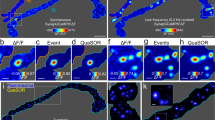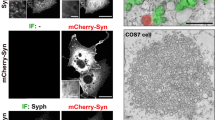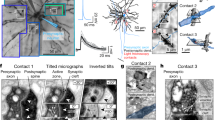Abstract
Active zone material at the nervous system's synapses is situated next to synaptic vesicles that are docked at the presynaptic plasma membrane, and calcium channels that are anchored in the membrane. Here we use electron microscope tomography to show the arrangement and associations of structural components of this compact organelle at a model synapse, the frog's neuromuscular junction. Our findings indicate that the active zone material helps to dock the vesicles and anchor the channels, and that its architecture provides both a particular spatial relationship and a structural linkage between them. The structural linkage may include proteins that mediate the calcium-triggered exocytosis of neurotransmitter by the synaptic vesicles during synaptic transmission.
This is a preview of subscription content, access via your institution
Access options
Subscribe to this journal
Receive 51 print issues and online access
$199.00 per year
only $3.90 per issue
Buy this article
- Purchase on Springer Link
- Instant access to full article PDF
Prices may be subject to local taxes which are calculated during checkout





Similar content being viewed by others
References
Peters, A., Palay, S. L. & Webster, H. de F. The Fine Structure of the Nervous System 198–203 (Oxford, Oxford, 1991).
Katz, B. The Release of Neural Transmitter Substances (Thomas, Springfield, 1969).
Couteaux, R. & Pécot-Dechavassine, M. Vésicules synaptiques et poches au niveau des “zones actives” de la jonction neuromusculaire. Compt. Rend. 271, 2346– 2349 (1970).
Heuser, J. E. & Reese, T. S. Structural changes after transmitter release at the frog neuromuscular junction. J. Cell Biol. 88, 564–580 (1981).
Palay, S. L. Synapses in the central nervous system. J. Biophys. Biochem. Cytol. 2 (Suppl.), 193–202 ( 1956).
Gray, E. G. Electron microscopy of presynaptic organelles of the spinal cord. J. Anat. 97, 101–106 ( 1963).
Gray, E. G. Problems of interpreting the fine structure of vertebrate and invertebrate synapses. Int. Rev. Gen. Exp. Zool. 2, 139 –170 (1966).
Heuser, J. E. & Reese, T. S. in Handbook of Physiology Vol. 1, 261–294 (American Physiological Society, Bethesda, 1977).
Frank, J. Electron Tomography: Three-Dimensional Imaging with the TEM (Plenum, New York, 1992).
Radermacher, M. Three-dimensional reconstruction of single particles from random and nonrandom tilt series. J. Electron Microsc. Tech. 9, 359–394 (1988).
Zhou, Z., Prasad, B., Jakana, J., Rixon, F. & Chiu, W. Protein subunit structures in the herpes simplex virus capsid from 400 kV spot-scan electron cryomicroscopy. J. Mol. Biol. 242 , 456–469 (1994).
Zwickl, P. et al. Primary structure of the thermoplasma proteasome and its implications for the structure, function, and evolution of the multicatalytic proteinase. Biochemistry 31, 964–972 (1994).
Moritz, M. et al. Three-dimensional structural characterization of centrosomes from early Drosophila embryos. J. Cell Biol. 130, 1149–1159 (1995).
Hoenger, A. & Aebi, U. 3-D reconstructions from ice-embedded and negatively stained biomacromolecular assemblies: A critical comparison. J. Struct. Biol. 117, 99– 116 (1996).
McEwen, B. F., Arena, J. T., Frank, J. & Rieder, C. L. Structure of the colcemid-treated PtK1 kinetochore outer plate as determined by high voltage electron microscopic tomography. J. Cell Biol. 120, 301–312 (1993).
Perkins, G. et al. Electron tomography of neuronal mitochondria: three-dimensional structure and organization of cristae and membrane contacts. J. Struct. Biol. 119, 260–272 (1997).
Ladinsky, M. S., Mastronarde, D. N., McIntosh, J. R., Howell, K. E. & Staehelin, L. A. Golgi structure in three dimensions: functional insights from the normal rat kidney cell. J. Cell Biol. 144, 1135–1149 ( 1999).
Lenzi, D., Runyeon, J. W., Crum, J., Ellisman, M. H. & Roberts, W. M. Synaptic vesicle populations in saccular hair cells reconstructed by electron tomography. J. Neurosci. 19, 119–132 (1999).
Heuser, J. E., Reese, T. S. & Landis, D. M. D. Functional changes in frog neuromuscular junctions studied with freeze-fracture. J. Neurocytol. 3, 109–131 (1974).
Robitalle, R., Alder, E. M. & Charlton, M. P. Strategic location of calcium channels at transmitter release sites of frog neuromuscular synapses. Neuron 5, 773–779 (1990).
Stanley, E. F. The calcium channel and the organization of the presynaptic transmitter release face. Trends Neurosci. 20, 404– 409 (1997).
Catterall, W. A. Structure and function of neuronal Ca2+ channels and their role in neurotransmitter release. Neuron 24, 307–323 (1998).
McMahan, U. J. & Slater, C. R. The influence of basal lamina on the accumulation of acetylcholine receptors at synaptic sites in regenerating muscle. J. Cell Biol. 98, 1453–1473 (1984).
Colledge, M. & Froehner, S. C. To muster a cluster: anchoring neurotransmitter receptors at synapses. Proc. Natl Acad. Sci. USA 95, 3341–3345 ( 1998).
Robitaille, R., Garcia, M. L., Kaczorowski, G. J. & Charlton, M. P. Functional colocalization of calcium and calcium-gated potassium channels in control of transmitter release. Neuron 11, 645–655 (1993).
Cohen, M. W., Hoffstrom, B. G. & DeSimone, D. W. Active zones on motor nerve terminals contain α3β1 integrin. J. Neurosci. 20, 4912– 4921 (2000).
Weber, T. et al. SNAREpins: minimal machinery for membrane fusion. Cell 92, 759–772 ( 1998).
Hazuka, C. D., Foletti, D. L. & Scheller, R. H. in Neurotransmitter Release (ed. Bellen, H. J.) 81–125 (Oxford Univ. Press, 1999).
Jahn, R. & Südhof, T. C. Membrane fusion and exocytosis. Annu. Rev. Biochem. 68, 863– 911 (1999).
Broadie, K., Bellen, H. K., DiAntonio, J., Littleton, J. T. & Schwarz, T. L. Absence of synaptotagmin disrupts excitation-secretion coupling during synaptic transmission. Proc. Natl Acad. Sci. USA 91, 10727–10731 (1994).
Pfeffer, S. R. Transport-vesicle targeting: tethers before SNAREs. Nature Cell Biol. 1, E17–E22 ( 1999).
Sunderland, W. J., Son, Y. -J., Miner, J. H., Sanes, J. R. & Carlson, S. S. The presynaptic calcium channel is part of a transmembrane complex linking a synaptic laminin (α4β2γ1) with non-erythoid spectrin. J. Neurosci. 20, 1009–1019 (2000).
Martin, P. T., Kaufman, S. J., Kamer, R. H. & Sanes, J. R. Synaptic integrins in developing, adult, and mutant muscle: selective association of α1, α7A, α7B integrins in the neuromuscular junction. Dev. Biol. 174, 125–139 (1996).
Bewick, G. S., Young, C. & Slater, C. R. Spatial relationships of utrophin, dystrophin, β-dystroglycan, and β-spectrin to acetylcholine receptor clusters during postnatal maturation of the rat neuromuscular junction. J. Neurocytol. 25 , 367–369 (1996).
Ress, D., Harlow, M., Schwarz, M., Marshall, R. M. & McMahan, U. J. Automatic acquisition of fiducial markers and alignment of images in tilt series for electron tomography. J. Electron Microsc. 48, 277–287 ( 1999).
Dierksen, K., Typke, D., Hegerl, R. & Baumeister, W. Towards automatic electron tomography. Ultramicroscopy 49, 109–120 (1992).
Dierksen, K. et al. Three dimensional structure of lipid vesicles embedded in vitreous ice and investigated by automatic electron tomography. J. Biophys. 68, 1416–1422 (1995).
Braunfeld, M., Koster, A., Sedat, J. & Agard, D. Cryo automated electron tomography: towards high-resolution reconstructions of plastic-embedded structures. J. Microsc. 174, 75–84 (1994).
Radermacher, M. in Electron Tomography: Three-Dimensional Imaging with the TEM (ed. Frank, J.) 91–115 (Plenum, New York, 1992).
Stoschek, A. & Hegerl, R. Denoising of electron tomographic reconstructions using multiscale transformations. J. Struct. Biol. 120, 257–265 ( 1997).
Wang, X. et al. Aczonin, a 550-kD putative scaffolding protein of presynaptic active zones, shares homology regions with Rim and Bassoon and binds profilin. J. Cell. Biol. 147, 151– 162 (1999).
Acknowledgements
We are grateful to W. Baumeister and members of the Department of Structural Biology at the Max-Planck Institute for Biochemistry in Martinsried, Germany, for use of their CM 200 electron microscope; A. Koster participated in the data collection for MPI-9 and MPI-10. We are also grateful to D. Agard and members of his laboratory in the Department of Biochemistry and Biophysics at the University of California San Francisco for use of the Philips EM 430; M. Braunfeld participated in the data collection for UC-1. T. Schwarz at Harvard Medical School provided comments on the manuscript, and B. Colyear at Stanford University made the schematic illustrations. This work was supported by grants from the NIH and the Deutsche Forschungsgemeinschaft, and by the M. A. Antelman Fund.
Author information
Authors and Affiliations
Corresponding author
Supplementary information
Rights and permissions
About this article
Cite this article
Harlow, M., Ress, D., Stoschek, A. et al. The architecture of active zone material at the frog's neuromuscular junction. Nature 409, 479–484 (2001). https://doi.org/10.1038/35054000
Received:
Accepted:
Issue Date:
DOI: https://doi.org/10.1038/35054000
This article is cited by
-
Synapse development and maturation at the drosophila neuromuscular junction
Neural Development (2020)
-
Presynaptic calcium channels: specialized control of synaptic neurotransmitter release
Nature Reviews Neuroscience (2020)
-
Statistical crossover and nonextensive behavior of neuronal short-term depression
Journal of Biological Physics (2018)
-
A stochastic model of active zone material mediated synaptic vesicle docking and priming at resting active zones
Scientific Reports (2017)
Comments
By submitting a comment you agree to abide by our Terms and Community Guidelines. If you find something abusive or that does not comply with our terms or guidelines please flag it as inappropriate.



